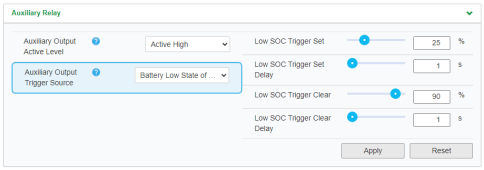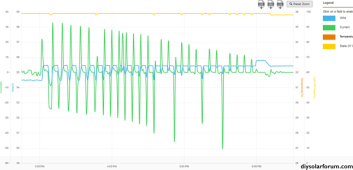For roughly the last six months I’ve been trying to get the settings dialed in on my XW Pro 6848 and MPPT 80/600 so it sells excess PV to the grid without depleting the battery bank (three EG4-LL 100A 5 KWh batteries, communicating on the Schneider Xanbus via the Insight Home). I was gradually getting it sorted out, having learned over a period of time that:
a. Neither “SOC Control” or the mysterious “Enhanced Grid Mode” does what is claimed in the manuals, at least in inverter firmware 1.11.01 bn 49)
b. Depending on what grid code you’re using (my electrical utility said they don’t care which I use), you get frequent extremely heavy selling from the battery (far in excess of the max sell amperage you've configured) as the inverter tries to prop the grid up through frequency, voltage, and power factor excursions. Depending on the duration and depth of the excursion, this would often result in the inverter dropping into AC Passthrough, then re-entering grid support a few seconds later.
The end result is that although I found the inverter/charger/battery combination to be rock-solid when off-grid or when Sell to Grid is disabled, like so many others have reported in this and other forums, selling your excess PV generation is sketchy at best.
Now within the last couple of weeks the inverter has stopped Selling to Grid and refuses to come out of AC Passthrough at all no matter what settings are applied, battery condition, etc. Even following an inverter reboot it will just sell to the grid for a few seconds, then drop into AC Passthrough and stay there. It is not throwing any alerts of any kind though.
I noticed that new firmware (2.04.00 bn 29 for the inverter, V1.17 bn 79 for Insight Home) is now available, both having features which would potentially improve the Grid Support performance. Unfortunately, my inverter still won't leave AC Passthrough with the new firmware loaded.
Even more ominously, I’ve noticed that when running the inverter off-grid (no grid connection at all), its output voltages tend to be lower compared to where they used to be (was typically 124/248 VAC, now more like 118/236VAC even under a fairly light load). Voltages are still normal while in AC Passthrough, and when the inverter is bypassed, indicating interconnections remain good.
All the above suggests to me that all the transitioning between Grid Support and AC Passthrough that resulted from over-selling to the Grid, draining the battery, etc has pitted some relay contacts somewhere in the bowels of the inverter.
Anybody have any similar experiences or better ideas? I contacted Schneider tech support through the website a couple days ago. I received an automated reply and case number back, but nothing since.
For what its worth, my system is intended mainly as a personal test-bed and includes both DC and AC-coupled PV, all installed as prescribed by the manuals and IAW the NEC. Even though its essentially dead in the water at the moment, I expect that with some better firmware (maybe 2.0 is it, I just haven’t been able to try it) and perhaps more education on my part, the XW Pro/EG4 combination is eventually going to be kick-butt. Will let you know what I find and hopefully save others from whatever problem I’ve run into.
John
.
a. Neither “SOC Control” or the mysterious “Enhanced Grid Mode” does what is claimed in the manuals, at least in inverter firmware 1.11.01 bn 49)
b. Depending on what grid code you’re using (my electrical utility said they don’t care which I use), you get frequent extremely heavy selling from the battery (far in excess of the max sell amperage you've configured) as the inverter tries to prop the grid up through frequency, voltage, and power factor excursions. Depending on the duration and depth of the excursion, this would often result in the inverter dropping into AC Passthrough, then re-entering grid support a few seconds later.
The end result is that although I found the inverter/charger/battery combination to be rock-solid when off-grid or when Sell to Grid is disabled, like so many others have reported in this and other forums, selling your excess PV generation is sketchy at best.
Now within the last couple of weeks the inverter has stopped Selling to Grid and refuses to come out of AC Passthrough at all no matter what settings are applied, battery condition, etc. Even following an inverter reboot it will just sell to the grid for a few seconds, then drop into AC Passthrough and stay there. It is not throwing any alerts of any kind though.
I noticed that new firmware (2.04.00 bn 29 for the inverter, V1.17 bn 79 for Insight Home) is now available, both having features which would potentially improve the Grid Support performance. Unfortunately, my inverter still won't leave AC Passthrough with the new firmware loaded.
Even more ominously, I’ve noticed that when running the inverter off-grid (no grid connection at all), its output voltages tend to be lower compared to where they used to be (was typically 124/248 VAC, now more like 118/236VAC even under a fairly light load). Voltages are still normal while in AC Passthrough, and when the inverter is bypassed, indicating interconnections remain good.
All the above suggests to me that all the transitioning between Grid Support and AC Passthrough that resulted from over-selling to the Grid, draining the battery, etc has pitted some relay contacts somewhere in the bowels of the inverter.
Anybody have any similar experiences or better ideas? I contacted Schneider tech support through the website a couple days ago. I received an automated reply and case number back, but nothing since.
For what its worth, my system is intended mainly as a personal test-bed and includes both DC and AC-coupled PV, all installed as prescribed by the manuals and IAW the NEC. Even though its essentially dead in the water at the moment, I expect that with some better firmware (maybe 2.0 is it, I just haven’t been able to try it) and perhaps more education on my part, the XW Pro/EG4 combination is eventually going to be kick-butt. Will let you know what I find and hopefully save others from whatever problem I’ve run into.
John
.




